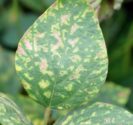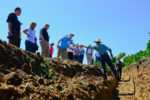Advertise Follow Us
No-Till Farmer News
The Connection Between Flooding and Farming Methods
Scientists say there's a way to at least decrease the amount of damage natural disasters can do and it all starts in the farm fields.
Read More
2019 National Strip-Tillage Conference Speaker
Testing Tillage Intensity: Learning from a Less is More Mindset
Longtime University of Illinois crop production researcher Emerson Nafziger to analyze and compare different tillage trials in continuous and rotated corn systems at 2019 National Strip-Tillage Conference.
Read More








